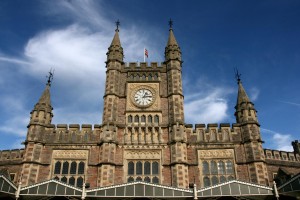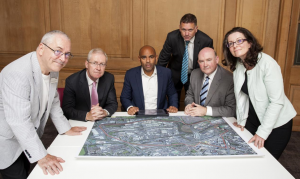Long-delayed plans to transform Bristol Temple Meads railway station came a step closer today with a new team appointed to develop a masterplan for it and the wider Temple Quarter.
The masterplan will cover a 70-hectare zone around the iconic station, pictured, and includes Temple Island – the site originally earmarked for Bristol’s much-delayed arena but which could now become a mixed-use development of homes, workplaces, retail and a hotel/conference centre if the arena is built at Filton. 
The city council said the consultants would “take into account both possible development scenarios for Temple Island but their work is not related to the decision-making process for the future of this site”.
A decision on the location of the arena could be announced by Mayor of Bristol Marvin Rees in early September.
The consortium, led by global engineering, management and development consultancy Mott MacDonald, will investigate ways to open up access to, and through, Bristol Temple Meads from the east of the city.
It will also look into the potential to bring forward new developments around the station including retail, office, housing and leisure facilities and wider Temple Quarter district, the city council said.
This initial phase of work is expected to take around nine months and will then lead to more detailed development of specific elements of the scheme, subject to funding.
The work was commissioned by the city council in partnership with the West of England Combined Authority, which is the main funder, Network Rail and Homes England, with the aim of accelerating the regeneration of the Temple Quarter district, including proposals for the development of the area around Bristol Temple Meads station.
Mayor Rees said: “We are currently the only major UK city without a modern railway station. At long last, that is about to change – thanks to the energy and commitment of the partnership we have brought together. A transformed station will finally give us a railway station fit for the 21st century, acting as a gateway to the West of England.
“The aim is that the redeveloped station will be accessible from the east of Bristol, removing a barrier that has divided the city. It will be connected to the new university enterprise campus and will unlock St Phillips Marsh – soon to become one of the largest regeneration schemes in Europe.
“Our long-term vision for Bristol is to grow a sustainable inclusive economy where everyone can share in the city’s success. This work represents a major step forward to making that happen.”
With its original passenger shed and engine shed designed and built by Brunel in 1840, Grade I listed Temple Meads is one of the oldest surviving railway terminus buildings in the world and one of the last remaining unimproved mainline train stations in the UK. Network Rail announce a ‘vision’ for the station six years ago which it said would transform it into a ‘world-class railway hub’.
The scheme, which also included opening up the east side of the station as well as bring two unused platforms back into use, was later abandoned after the funding was withdrawn. In the meantime, Birmingham’s New Street station wastransformed with a £750m facelift.
It handles around 10m passengers a year – a figure expected to rise to more than 22m by 2030, meaning much greater capacity, improved access and better facilities will be needed in the long term.
The University of Bristol is to build an Enterprise Campus next to the station on the site of the derelict former Royal Mail sorting office. The Temple Meads are is also an important regional transport interchange linking the railway with key bus routes – including Metrobus and services to Bristol Airport – making it critical to ongoing economic and housing growth in the West of England.
West of England Metro Mayor Tim Bowles said: “Temple Meads is one of our most valuable assets and improvements at this key regional hub will help realise the West of England’s economic ambitions.
“The Combined Authority is committing up to £2m into the masterplan development and I look forward to seeing a scheme which is deliverable, affordable and meets the high expectations of the region, in terms of delivering a new mixed-use quarter (Temple Quarter) and a gateway to the West of England.”
Network Rail is already investing £3m in the station this October to install two new sets of ticket barriers which will ease congestion for people entering and exiting the station. A further £40m investment to renovate the station’s historic roof is planned for the next five years.
Network Rail director of route business development for its Western route, Francis McGarry, said: “The railway station is often the shop window to a city and we are proud of the heritage of Brunel’s Grade I listed Bristol Temple Meads.
“We are also committed to improving the facilities to enhance the experience for passengers as well as ensuring the station can cope with the growing numbers that use the station.
“We are looking forward to seeing how the masterplanning team will help continue the regeneration in the area and build upon the railway upgrades we are making in Bristol that will provide more frequent services, thousands more seats and quicker journeys.”
Homes England South West general manager Kevin Bourner said: “It’s fantastic that Homes England is part of the delivery team on this transformational regeneration project at the heart of Bristol.
“The masterplanning is the first step in much wider collaboration which will see up to 11,000 new homes delivered at Bristol Temple Quarter alongside new jobs and infrastructure.We look forward to seeing the masterplan for this historic area of the city develop.”
Mott MacDonald’s global practice leader for cities and the project director Clare Wildfire said: “We are delighted that our team has been selected to deliver such a transformational project for Bristol, its citizens and the region. It will establish a fitting gateway to Bristol and the wider West of England and transform Temple Quarter into a people-focused place with affordable, good quality homes and space for innovative businesses.”
The wider consortium, led by Mott MacDonald, includes London-based architects Weston Williamson + Partners, Bristol-based AWW Architects, civil engineering design consultancy Alan Baxter associates, accountants Deloitte, property agents GVA, planning consultants Turley, Bristol-headquartered national law firm TLT and Pragma, a London-based retail and leisure property consultancy.
Pictured above: Members of the masterplan consortium with Mayor of Bristol Marvin Rees, seated centre, and Metro Mayor Tim Bowles, seated second from right






























